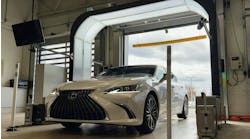P0420 and P0430 are juts two generic codes related to catalyst efficiency.
For vehicles using conventional oxygen sensors, sensor switch rates are compared to one another, either directly or by an Index Ratio method. In normal operation, the ECM adjusts Short Term Fuel Trim (STFT) to get the pre-cat sensor to switch across center in order to maintain the proper fuel mixture (see Oxygen Sensors? Not Really...). That results in alternating lean/rich mixtures reaching the catalytic converter. Ideally, these mixtures are oxidized before leaving the cat and reaching the post-cat oxygen sensor.
The post-cat sensor responds to these "dampened" combustion mixtures by switching more slowly and not reaching the same peak voltage levels like those you would normally see on the pre-cat sensor. As the catalytic converter loses its oxygen storage capacity, less and less of these gases are oxidized, and the post-cat sensor begins to mirror the activity of the pre-cat sensor.When the response of the post-cat sensor, as compared to the pre-cat sensor, exceeds the test thresholds of the ECM, the ECM records a "Catalyst Efficiency Below Threshold" code.
Wideband oxygen sensors offer a linear response to changes in combustion mixtures and do not switch like conventional sensors do. But the post-cat sensor is still a conventional sensor. For those vehicles I checked researching this article, both sensors still provide vital information to the ECM when checking the oxygen storage capacity of the converter. The difference is in how the ECM conducts the test, and the results it is looking for. The ECM purposely alters fuel trim lean and rich of stoichiometric. This sudden change results in a response from the post-cat sensor and the ECM monitors how long it takes for the post-cat sensor voltage to shift.Another method used is to monitor the peak voltages generated by the post-cat sensor when fuel mixture is altered from lean to rich. If the actual voltages do not meet the expected levels, the ECM will record the fault.
In all cases, the ECM doesn't rely on just one comparison. It may take a few hundred samples over the course of the monitor.
In some instances, this test information is stored in the event the Catalytic Converter Monitor does not complete its testing, and applies that information on the next attempt. By following the specific drive cycle of the vehicle you are testing, you can let the ECM confirm the fault and verify your repair.
Pete Meier is an ASE CMAT, member of iATN, and full-time tech in Tampa, Fla. His experience reaches back more than 30 years, and his contributions to Motor Age reflect a wide variety of experience with almost every make and model. You can contact Meier directly at www.autoservicetech.com.


